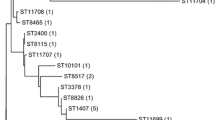Abstract
In the study presented here 26 recent Danish clinical isolates of prolyliminopeptidase (PIP)-negative Neisseria gonorrhoeae were phenotypically and genotypically characterized to investigate whether one or more PIP-negative strains are circulating in the Danish community. The profiles of these isolates were compared with those of three isolates from a recent outbreak of PIP-negative N. gonorrhoeae infection in the UK. Twenty-five of the Danish isolates and all three UK isolates had similar antibiograms and were designated serovar IB-4. Genotypic characterization by pulsed-field gel electrophoresis, porB1b gene sequencing, and opa-typing revealed that these isolates were indistinguishable or closely related. The results indicate that at least one PIP-negative N. gonorrhoeae strain is currently circulating in the Danish community, and this strain is indistinguishable from the one that caused an outbreak in the UK.


Similar content being viewed by others
References
Berglund T, Unemo M, Olcén P, Giesecke J, Fredlund H (2002) One year of Neisseria gonorrhoeae isolates in Sweden: the prevalence study of antibiotic susceptibility shows relation to the geographic area of exposure. Int J STD AIDS 13:109–114
Tanaka M, Nakayama H, Haraoka M, Saika T, Kobayashi I, Naito S (2000) Antimicrobial resistance of Neisseria gonorrhoeae and high prevalence of ciprofloxacin-resistant isolates in Japan, 1993 to 1998. J Clin Microbiol 38:521–525
Palmer HM, Wu S, Gough KR, Hemming MN, Hassan I, Turner A (2002) An increase in prolyliminopeptidase-negative isolates of Neisseria gonorrhoeae in the United Kingdom is associated with the spread of a single clonal strain. In: Abstracts of the 13th International Pathogenic Neisseria Conference, p 387
Sandström E, Danielsson D (1980) Serology of Neisseria gonorrhoeae. Classification by co-agglutination. Acta Pathol Microbiol Scand Sect B 88:27–38
Knapp JS, Tam MR, Nowinski RC, Holmes KK, Sandström EG (1984) Serological classification of Neisseria gonorrhoeae with use of monoclonal antibodies to gonococcal outer membrane protein I. J Infect Dis 150:44–48
Unemo M, Berglund T, Olcén P, Fredlund H (2002) Pulsed-field gel electrophoresis as an epidemiologic tool for Neisseria gonorrhoeae identification of clusters within serovars. Sex Transm Dis 29:25–31
Tenover FC, Arbeit RD, Goering RV (1997) How to select and interpret molecular strain typing methods for epidemiological studies of bacterial infections: a review for healthcare epidemiologists. Infect Control Hosp Epidemiol 18:426–439
Unemo M, Olcén P, Berglund T, Albert J, Fredlund H (2002) Molecular epidemiology of Neisseria gonorrhoeae: sequence analysis of the porB gene confirms presence of two circulating strains. J Clin Microbiol 40:3741–3749
van der Ley P, Heckels JE, Virji M, Hoogerhout P, Poolman JT (1991) Topology of outer membrane porins in pathogenic Neisseria spp. Infect Immun 59:2963–2971
Felsenstein J (1985) Confidence limits on phylogenies: an approach using the bootstrap. Evolution 39:783–791
van de Peer Y, De Wachter R (1994) TREECON for Windows: a software package for the construction and drawing of evolutionary trees for the Microsoft Windows environment. Comput Appl Biosci 10:569–570
Palmer HM, Leeming JP, Turner A (2001) Investigation of an outbreak of ciprofloxacin-resistant Neisseria gonorrhoeae using a simplified opa-typing method. Epidemiol Infect 126:219–224
O’Rourke M, Ison CA, Renton AM, Spratt BG (1995) Opa-typing: a high-resolution tool for studying the epidemiology of gonorrhoea. Mol Microbiol 17:865–875
Author information
Authors and Affiliations
Corresponding author
Additional information
An erratum to this article can be found at http://dx.doi.org/10.1007/s10096-005-1352-4
Rights and permissions
About this article
Cite this article
Fjeldsøe-Nielsen, H., Unemo, M., Fredlund, H. et al. Phenotypic and genotypic characterization of prolyliminopeptidase-negative Neisseria gonorrhoeae isolates in Denmark. Eur J Clin Microbiol Infect Dis 24, 280–283 (2005). https://doi.org/10.1007/s10096-005-1319-5
Published:
Issue Date:
DOI: https://doi.org/10.1007/s10096-005-1319-5




